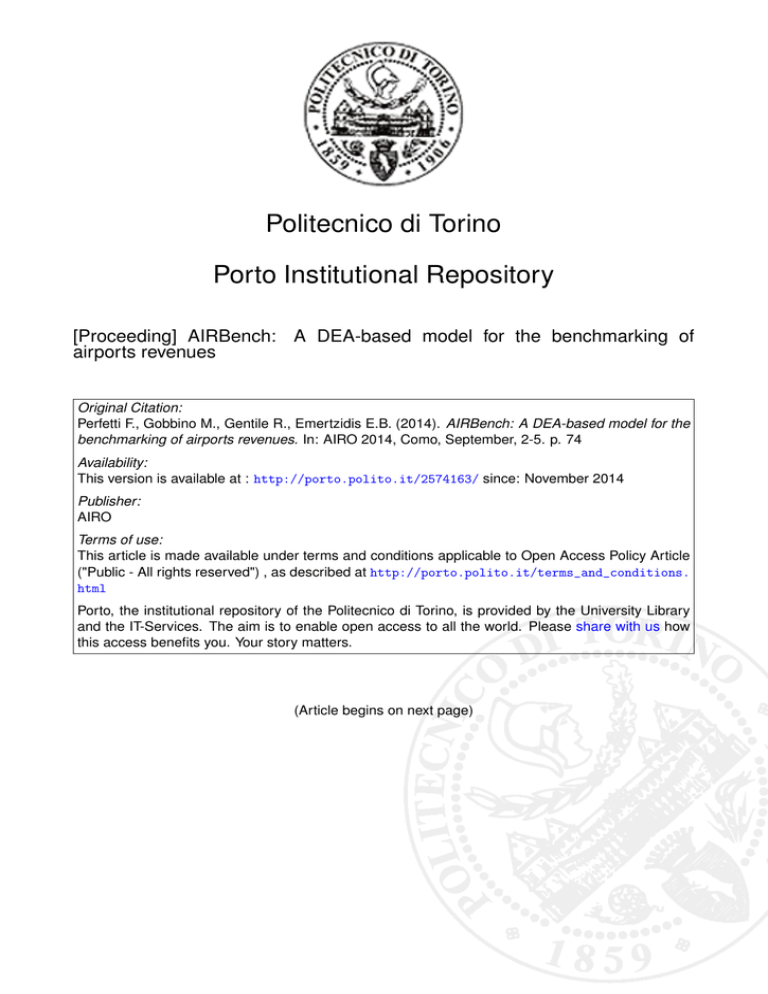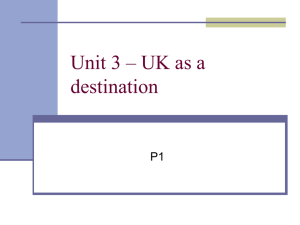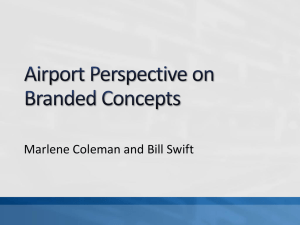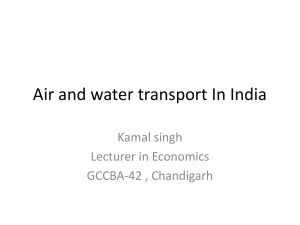
Politecnico di Torino
Porto Institutional Repository
[Proceeding] AIRBench: A DEA-based model for the benchmarking of
airports revenues
Original Citation:
Perfetti F., Gobbino M., Gentile R., Emertzidis E.B. (2014). AIRBench: A DEA-based model for the
benchmarking of airports revenues. In: AIRO 2014, Como, September, 2-5. p. 74
Availability:
This version is available at : http://porto.polito.it/2574163/ since: November 2014
Publisher:
AIRO
Terms of use:
This article is made available under terms and conditions applicable to Open Access Policy Article
("Public - All rights reserved") , as described at http://porto.polito.it/terms_and_conditions.
html
Porto, the institutional repository of the Politecnico di Torino, is provided by the University Library
and the IT-Services. The aim is to enable open access to all the world. Please share with us how
this access benefits you. Your story matters.
(Article begins on next page)
Elisa Emertzidis1 , Renzo Gentile2 , Marcella Gobbino2 and Francesca Perfetti𝟏,𝟐
1
Politecnico di Torino, Turin, Italy,
2
BDS s.r.l., Turin, Italy
September 2014
Agenda
Our work motivations and contest
DEA methodology: some concepts
Airports benchmarking analysis and its application
Conclusions
2
Work motivation
The project arises from the collaboration between the ORO
Group of the Politecnico di Torino and the BDS S.r.l.
The target is the development of a tool able to support airport
managers in their activities and measure the overall
assessment of airports performance.
Nowadays, airport performance is linked to both aviation
activities and commercial activities, which are becoming
increasingly important sector of airport performance.
The benchmarking analysis allows highlighting airport target and
suggesting which sectors airport management should invest on.
3
The State of the Art
Many studies have been carried out on the airport benchmarking
analysis.
Previous studies only focus on aviation activities for the
evaluation of airports efficiency.
Recently, few articles have considered commercial activities:
De Nicola, A., Gitto, S., & Mancuso, P. (2013). Airport quality and
productivity changes: A Malmquist index decomposition
assessment. Transportation Research Part E: Logistics and Transportation
Review, 58, 67-75.
Gitto, S., & Mancuso, P. (2010). Airport efficiency: a DEA two stage
analysis of the Italian commercial airports.
4
The State of the Art
The major limit of these more recent studies is that they include
quality indicators of the Italian service charter, defined by the
Italian Civil Aviation Authority (ENAC).
The service charter does not exist for European airports.
Their methodology is not easily applicable to European
airports.
5
The Data Envelopment
Analysis
The benchmarking analysis is realized through the Data
Envelopment Analysis (DEA) methodology.
DEA is a non-parametrical and deterministic approach widely
used in literature for evaluating the relative efficiency of different
decision making units (DMUs), like airports, public or private
enterprises, etc.
DEA models assume the homogeneity of the units under
evaluation, i.e. the DMUs produce the same type of outputs with
the same type of inputs.
6
DEA models
The DEA methodology provides many models for the evaluation
of the relative efficiency.
CCR model: it allows to evaluate the global efficiency, which
is given by the product of the technical efficiency and the scale
efficiency.
BCC model: it allows to evaluate the technical efficiency,
which measures the DMU efficiency considering its operational
capability.
The ratio between the CCR and the BCC indices provides the
scale efficiency index which expresses whether and how much
the size of the DMU influences its global efficiency.
7
Benchmark methodology:
Data retrieval process
The benchmarking uses only data that can be obtained by public
available sources and databases
The data has been retrieved from balance sheets and profit and
loss accounts, airports websites and ENAC data.
Differently from other works in literature, both the aviation
and the commercial activities are considered to evaluate the
airport performance.
Main difficulty: the non-homogeneity of the airports balance
sheets required a detailed analysis.
Occasional and exceptional revenues have been excluded.
8
Benchmark methodology:
Identification of the best variables for the model
The plurality of different optimal solutions of DEA required a
reiterative process to guide the model towards the solution that
better represented the market.
Many tests with many different inputs and outputs were
carried out in order to find the best variables for the model.
A preliminary knowledge of the market was necessary.
9
DEA Model
Inputs and Outputs
Input oriented CCR and BCC DEA models.
Each airport is a DMU.
We select 4 inputs:
2 inputs related to the commercial activities:
commercial surface (Sqm);
marketing mix index (mix of service categories of the airport)
2 inputs related to the aviation activities:
Number of airlines;
Accessibility index (Hansen index)
We select 2 outputs:
2012 commercial revenues per passenger
2012 aviation revenues per passenger
10
Benchmark analysis:
Application
Sample of 23 airports: 18 in Italy and 5 in the rest of Europe .
The sample is divided into big-sized, medium-sized and smallsized airports.
Big-sized airports
>10 million passengers/year
Medium-sized airports
>5 and <10 million passengers/year
Small-sized airports
<5 million passenger/year
Hamburg
Bari and Brindisi
Florence
Amsterdam
Bergamo
Lamezia Terme
Athens
Bologna
Olbia
Frankfurt
Catania
Palermo
London Heathrow
Naples
Pisa
London Stansted
Venice
Turin
Milan (Malpensa and Linate)
Treviso
Paris
Rome (Fiumicino and Ciampino)
Wien
11
Benchmark analysis
For every airport we evaluate:
The global efficiency
The technical efficiency
The scale efficiency
For the inefficient airports, we realize:
Peers analysis: the model provides a target airport (peer) that airport
managers whose airport is inefficient need to catch up to.
Weights structure analysis: a detailed analysis of the weights of
inputs and outputs is carried out in order to understand which are the
main structural differences between the inefficient airport and its target
and to find the causes for the inefficiency and some possible corrective
actions.
12
Efficiency indices:
Big-sized airports
Big-sized airports
DMUs
CCR
BCC
efficiency efficiency
SCALE
POSITION ON
efficiency
THE FRONTIER
CCR/BCC
Hamburg
0,507
0,552
0,917
IRS
Amsterdam
0,558
0,726
0,769
IRS
Athens
1
1
1
CRS
Frankfurt
1
1
1
CRS
London Heathrow
1
1
1
CRS
London Stansted
1
1
1
CRS
Milan (Malpensa & Linate)
0,955
1
0,955
DRS
Paris
Rome (Fiumicino
&Ciampino)
Wien
1
1
1
CRS
0,594
0,974
0,610
IRS
1
1
1
CRS
TARGET (PEER)
from the CCR model
London Heathrow,
Wien, Turin.
London Stansted,
Paris
Paris, Wien, Turin.
Paris, Turin.
13
Efficiency indices:
Big-sized airports
Big-sized airports
DMUs
CCR
BCC
efficiency efficiency
SCALE
POSITION ON
efficiency
THE FRONTIER
CCR/BCC
TARGET (PEER)
from the CCR model
Hamburg
0,507
0,552
0,917
IRS
London Heathrow, Wien,
Turin.
Amsterdam
0,558
0,726
0,769
IRS
London Stansted, Paris.
Athens
1
1
1
CRS
It indicatesFrankfurt
the type of Returns
To 1Scale (RTS):
it expresses
the direction of
1
1
CRS
marginalLondon
rescaling
that the DMU
should
undertake
in order
to improve its
Heathrow
1
1
1
CRS
efficiency.
London Stansted
1
1
1
CRS
If a DMU
exhibits CRS, it operates
at the most
efficient
scale size.
Milan (Malpensa & Linate)
0,955
Paris, Wien, Turin.
If it exhibits
IRS, it would0,955
achieve it1 by scaling
the size DRS
of its operations
up.
Paris
1
1
1
CRS
If the DMU exhibits DRS, it would achieve it by scaling its operations down.
Rome (Fiumicino &Ciampino)
0,594
0,974
0,610
IRS
Paris, Turin.
Wien
1
1
1
CRS
Wien, Turin.
14
Efficiency indices:
Big-sized airports
Big-sized airports
DMUs
CCR
BCC
efficiency efficiency
SCALE
POSITION ON
efficiency
THE FRONTIER
CCR/BCC
TARGET (PEER)
from the CCR model
Hamburg
0,507
0,552
0,917
IRS
London Heathrow, Wien,
Turin.
Amsterdam
0,558
0,726
0,769
IRS
London Stansted, Paris.
Athens
1
1
1
CRS
Frankfurt
1
1
1
CRS
London Heathrow
1
1
1
CRS
London Stansted
1
1
1
CRS
Milan (Malpensa & Linate)
0,955
1
0,955
DRS
Paris
1
1
1
CRS
Rome (Fiumicino &Ciampino)
0,594
0,974
0,610
IRS
Paris, Turin.
Wien
1
1
1
CRS
Wien, Turin.
Paris, Wien, Turin.
15
Peer analysis
BIG AIRPORTS
100%
Torino
35%
37%
80%
Vienna
61%
62%
Parigi
60%
100%
40%
63%
100%
100%
100%
100%
100%
4%
65%
32%
20%
0%
36%
6%
Londra Stansted
Londra
Heathrow
Francoforte
Atene
-20%
18
Peer analysis
BIG AIRPORTS
100%
Torino
35%
37%
80%
Vienna
61%
62%
Parigi
60%
100%
40%
63%
100%
100%
100%
100%
100%
4%
65%
32%
20%
0%
36%
6%
Londra Stansted
Londra
Heathrow
Francoforte
Atene
-20%
19
Weights analysis example:
ROME AIRPORT
Analysing the weights of Rome airport and of its peer Paris, we
obtain information about the structure of the two airports.
Rome has the same structure of Paris: the two airports allocate
similar weights to the same inputs and outputs.
Both explain their efficiency using only the commercial activities.
DMUs
2012 Aviation
2012 NonCommercial surface Marketing
revenues per aviation revenues
Airlines Accessibility
(Sqm) per passenger
Mix
passenger
per passenger
Paris
0
0,063
1,124
0,001
0
0
Rome
0
0,088
1,927
0,015
0
0
20\
Initial data analysis
To better understand the weights assignment in the estimation of
the efficiency, we consider also the initial data, which provides
information on the quantity of sources used and of outputs
produced.
DMUs
2012 Aviation
2012 NonCommercial surface Marketing
revenues per aviation revenues
Airlines Accessibility
(Sqm) per passenger
Mix
passenger
per passenger
Paris
17,8
15,77
0,197
68,5
139
0,841
Rome
7,7
6,72
0,197
42
149
1,010
Since Rome has a low marketing mix, revenues result lower than
those of its target: Rome results commercially inefficient.
21
Conclusions
We developed an DEA-based airports benchmarking
methodology, which
is a standard tool, based on public data
considers both aviation and commercial activities
considers both economic and non-economic data
Thanks to the DEA-based airports benchmarking:
we identified the overall assessment of airports
performance
for airport managers whose airport is inefficient, we
identified the target airports they need to catch up to and
which factors they should invest on to reach the efficiency.
22
Thank you
Elisa Emertzidis, Renzo Gentile, Marcella Gobbino and
Francesca Perfetti
September 2014







